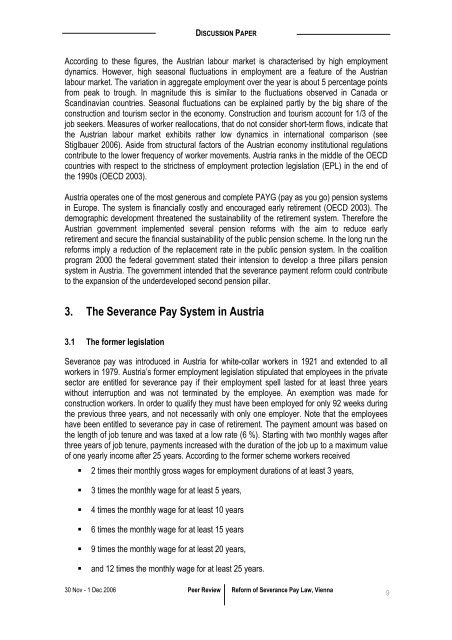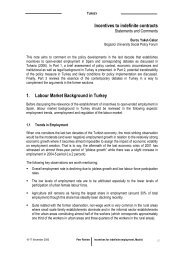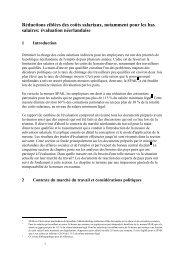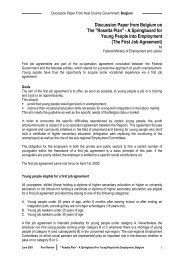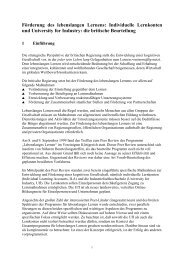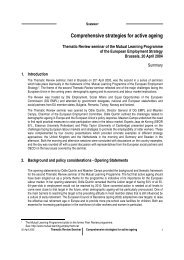Reform of Severance Pay Law in Austria - mutual learning programme
Reform of Severance Pay Law in Austria - mutual learning programme
Reform of Severance Pay Law in Austria - mutual learning programme
Create successful ePaper yourself
Turn your PDF publications into a flip-book with our unique Google optimized e-Paper software.
DISCUSSION PAPER<br />
Accord<strong>in</strong>g to these figures, the <strong>Austria</strong>n labour market is characterised by high employment<br />
dynamics. However, high seasonal fluctuations <strong>in</strong> employment are a feature <strong>of</strong> the <strong>Austria</strong>n<br />
labour market. The variation <strong>in</strong> aggregate employment over the year is about 5 percentage po<strong>in</strong>ts<br />
from peak to trough. In magnitude this is similar to the fluctuations observed <strong>in</strong> Canada or<br />
Scand<strong>in</strong>avian countries. Seasonal fluctuations can be expla<strong>in</strong>ed partly by the big share <strong>of</strong> the<br />
construction and tourism sector <strong>in</strong> the economy. Construction and tourism account for 1/3 <strong>of</strong> the<br />
job seekers. Measures <strong>of</strong> worker reallocations, that do not consider short-term flows, <strong>in</strong>dicate that<br />
the <strong>Austria</strong>n labour market exhibits rather low dynamics <strong>in</strong> <strong>in</strong>ternational comparison (see<br />
Stiglbauer 2006). Aside from structural factors <strong>of</strong> the <strong>Austria</strong>n economy <strong>in</strong>stitutional regulations<br />
contribute to the lower frequency <strong>of</strong> worker movements. <strong>Austria</strong> ranks <strong>in</strong> the middle <strong>of</strong> the OECD<br />
countries with respect to the strictness <strong>of</strong> employment protection legislation (EPL) <strong>in</strong> the end <strong>of</strong><br />
the 1990s (OECD 2003).<br />
<strong>Austria</strong> operates one <strong>of</strong> the most generous and complete PAYG (pay as you go) pension systems<br />
<strong>in</strong> Europe. The system is f<strong>in</strong>ancially costly and encouraged early retirement (OECD 2003). The<br />
demographic development threatened the susta<strong>in</strong>ability <strong>of</strong> the retirement system. Therefore the<br />
<strong>Austria</strong>n government implemented several pension reforms with the aim to reduce early<br />
retirement and secure the f<strong>in</strong>ancial susta<strong>in</strong>ability <strong>of</strong> the public pension scheme. In the long run the<br />
reforms imply a reduction <strong>of</strong> the replacement rate <strong>in</strong> the public pension system. In the coalition<br />
program 2000 the federal government stated their <strong>in</strong>tension to develop a three pillars pension<br />
system <strong>in</strong> <strong>Austria</strong>. The government <strong>in</strong>tended that the severance payment reform could contribute<br />
to the expansion <strong>of</strong> the underdeveloped second pension pillar.<br />
3. The <strong>Severance</strong> <strong>Pay</strong> System <strong>in</strong> <strong>Austria</strong><br />
3.1 The former legislation<br />
<strong>Severance</strong> pay was <strong>in</strong>troduced <strong>in</strong> <strong>Austria</strong> for white-collar workers <strong>in</strong> 1921 and extended to all<br />
workers <strong>in</strong> 1979. <strong>Austria</strong>’s former employment legislation stipulated that employees <strong>in</strong> the private<br />
sector are entitled for severance pay if their employment spell lasted for at least three years<br />
without <strong>in</strong>terruption and was not term<strong>in</strong>ated by the employee. An exemption was made for<br />
construction workers. In order to qualify they must have been employed for only 92 weeks dur<strong>in</strong>g<br />
the previous three years, and not necessarily with only one employer. Note that the employees<br />
have been entitled to severance pay <strong>in</strong> case <strong>of</strong> retirement. The payment amount was based on<br />
the length <strong>of</strong> job tenure and was taxed at a low rate (6 %). Start<strong>in</strong>g with two monthly wages after<br />
three years <strong>of</strong> job tenure, payments <strong>in</strong>creased with the duration <strong>of</strong> the job up to a maximum value<br />
<strong>of</strong> one yearly <strong>in</strong>come after 25 years. Accord<strong>in</strong>g to the former scheme workers received<br />
• 2 times their monthly gross wages for employment durations <strong>of</strong> at least 3 years,<br />
• 3 times the monthly wage for at least 5 years,<br />
• 4 times the monthly wage for at least 10 years<br />
• 6 times the monthly wage for at least 15 years<br />
• 9 times the monthly wage for at least 20 years,<br />
• and 12 times the monthly wage for at least 25 years.<br />
30 Nov - 1 Dec 2006 Peer Review <strong>Reform</strong> <strong>of</strong> <strong>Severance</strong> <strong>Pay</strong> <strong>Law</strong>, Vienna<br />
9


